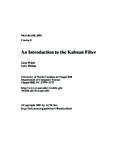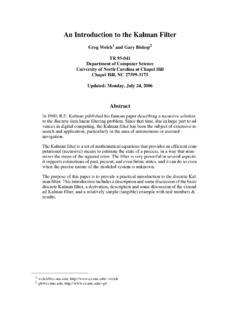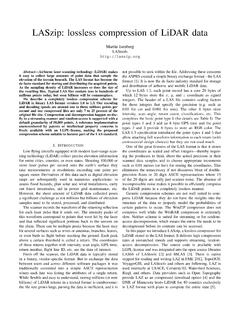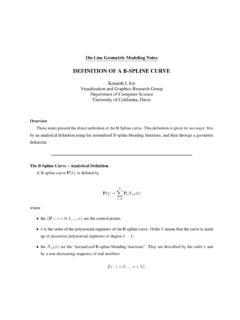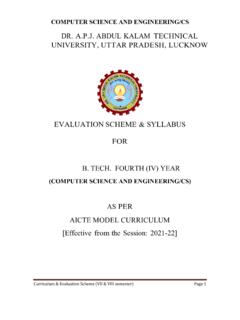Transcription of File Formats - Computer Science
1 File Formatsfor VTK Version (Taken fromThe VTK User s GuideContact Kitware to purchase)VTK File FormatsTheVisualization Toolkitprovides a number of source and writer objects to read and write popular data file Formats . TheVisualization Toolkitalso provides some of its own file Formats . The main reason for creating yet another data file formatis to offer a consistent data representation scheme for a variety of dataset types, and to provide a simple method to com-municate data between software. Whenever possible, we recommend that you use Formats that are more widely used. Butif this is not possible, theVisualization Toolkitformats described here can be used instead. Note that these Formats may notbe supported by many other are two different styles of file Formats available in VTK.
2 The simplest are the legacy, serial Formats that areeasy to read and write either by hand or programmatically. However, these Formats are less flexible than the XML basedfile Formats described later in this section. The XML Formats support random access, parallel I/O, and portable data com-pression and are preferred to the serial VTK file Formats whenever Legacy FormatsThe legacy VTK file Formats consist of five basic first part is the file version and identifier. This part contains the single line:# vtk DataFile Version line must be exactly as shown with the exception of the version , which will vary with differentreleases of VTK. (Note: the current version number is Version and files are compatible with version ) second part is the header.
3 The header consists of a character string terminated by end-of-line character\ is 256 characters maximum. The header can be used to describe the data and include any other next part is the file format. The file format describes the type of file, either ASCII or binary. On this line the sin-gle wordASCIIorBINARY must fourth part is the dataset structure. The geometry part describes the geometry and topology of the dataset. Thispart begins with a line containing the keywordDATASET followed by a keyword describing the type of , depending upon the type of dataset, other keyword/data combinations define the actual final part describes the dataset attributes. This part begins with the keywordsPOINT_DATAorCELL_DATA,fol-lowed by an integer number specifying the number of points or cells, respectively.
4 (It doesn t matter whetherPOINT_DATAorCELL_DATA comes first.) Other keyword/data combinations then define the actual dataset attributevalues ( , scalars, vectors, tensors, normals, texture coordinates, or field data).An overview of the file format is shown inFigure 1. The first three parts are mandatory, but the other two are you have the flexibility of mixing and matching dataset attributes and geometry, either by operating system filemanipulation or using VTK filters to merge data. Keywords are case insensitive, and may be separated by describing the data file Formats please note the following. dataTypeis one of the typesbit,unsigned_char,char,unsigned_sho rt,short,unsigned_int,int,unsigned_long, long,float,ordouble.
5 These keywords are used to describe the form of the data, both forreading from file, as well as constructing the appropriate internal objects. Not all data types are supported for File Formats All keyword phrases are written in ASCII form whether the file is binary or ASCII. The binary section of the file (ifin binary form) is the data proper; , the numbers that define points coordinates, scalars, cell indices, and so forth. Indices are 0-offset. Thus the first point is point id 0. If both the data attribute and geometry/topology part are present in the file, then the number of data values definedin the data attribute part must exactly match the number of points or cells defined in the geometry/topology part. Cell types and indices are of typeint.
6 Binary data must be placed into the file immediately after the newline (\n) character from the previous ASCII keyword and parameter sequence. The geometry/topology description must occur prior to the data attribute files in VTK are portable across different Computer systems as long as you observe two , make sure that the byte ordering of the data is correct, and second, make sure that the length of each data type is of the time VTK manages the byte ordering of binary files for you. When you write a binary file on one com-puter and read it in from another Computer , the bytes representing the data will be automatically swapped as example, binary files written on a Sun are stored in big endian order, while those on a PC are stored in little endianorder.
7 As a result, files written on a Sun workstation require byte swapping when read on a PC. (See the classvtkByteSwap for implementation details.) The VTK data files described here are written in big endian file Formats , however, do not explicitly define a byte ordering form. You will find that data read or written byexternal programs, or the classes vtkVolume16 Reader, vtkMCubesReader, and vtkMCubesWriter may have a differentbyte order depending on the system of origin. In such cases, VTK allows you to specify the byte order by using the meth-odsSetDataByteOrderToBigEndian()Set DataByteOrderToLittleEndian()Part 4: one of:STRUCTURED_POINTSSTRUCTURED_GRIDUNSTR UCTURED_GRIDPOLYDATARECTILINEAR_GRIDFIEL DPart 5:Dataset attributes.
8 The number of dataitemsnof each type must match the numberof points or cells in the dataset. (IftypeisFIELD, point and cell data should be 1 overview of five parts of VTK data file format.# vtk DataFile Version cool dataASCII | 1:HeaderPart 2:Title (256 characters maximum, termi-nated with newline\ncharacter)Part 3:Data type, either ASCII or BINARY(1)(2)(3)(4)(5)Simple Legacy Formats3 Another problem with binary files is that systems may use a different number of bytes to represent an integer or othernative type. For example, some 64-bit systems will represent an integer with 8-bytes, while others represent an integerwith 4-bytes. Currently, theVisualization Toolkitcannot handle transporting binary files across systems with incompatibledata length.)
9 In this case, use ASCII file Formats Toolkitsupports five different dataset Formats : structured points, structured grid, recti-linear grid, unstructured grid, and polygonal data. Data with implicit topology (structured data such as vtkImageData andvtkStructuredGrid) are ordered withxincreasing fastest, theny,thenz. These Formats are as follows. Structured PointsThe file format supports 1D, 2D, and 3D structured point datasets. The dimensionsnx,ny,nzmust be greater than orequal to 1. The data spacingsx,sy,szmust be greater than 0. (Note: in the version data file, spacing was referredto as aspect ratio .ASPECT_RATIOcan still be used in version data files, but is discouraged.)DATASET STRUCTURED_POINTSDIMENSIONS nxnynzORIGINxyzSPACING sxsysz Structured GridThe file format supports 1D, 2D, and 3D structured grid datasets.
10 The dimensionsnx,ny,nzmust be greater than orequal to 1. The point coordinates are defined by the data in thePOINTS section. This consists ofx-y-zdata values foreach STRUCTURED_GRIDDIMENSIONS nxnynzPOINTSn (n-1)xp(n-1)yp(n-1)z Rectilinear GridA rectilinear grid defines a dataset with regular topology, and semi-regular geometry aligned along thex-y-zcoordi-nate axes. The geometry is defined by three lists of monotonically increasing coordinate values, one list for each ofthex-y-zcoordinate axes. The topology is defined by specifying the grid dimensions, which must be greater than orequal to (nx-1) (ny-1) (nz-1) Polygonal DataThe polygonal dataset consists of arbitrary combinations of surface graphics primitives vertices (and polyvertices),lines (and polylines), polygons (of various types), and triangle strips.
